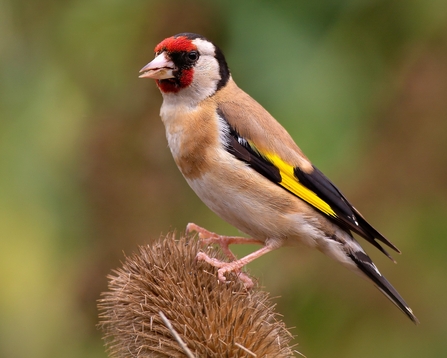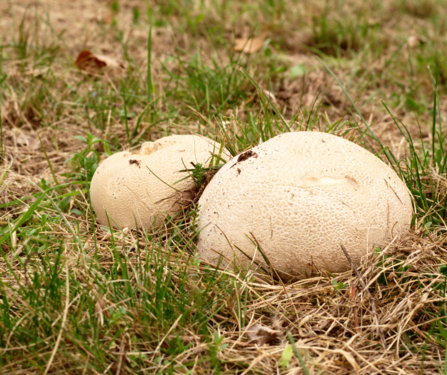
Autumn lady's-tresses by Adrian Wallington.
The dragonfly may be fast, but it's no match for the hobby! Photo by Jon Hawkins.

Autumn lady's-tresses by Adrian Wallington.
From late summer to the end of September, when conditions are right, you may see thousands of autumn lady’s-tresses in the grassland at Greenham Common.
This delicate plant is a late-summer flowering orchid with white, bell-shaped flowers arranged in a single spiral around the stem. The plants growing at Greenham Common may form the largest population on a single site in southern Britain.
The best spot to see these beautiful, snow-white flowers twirling around soft, grey stems is on the short turf 100 metres east of the Control Tower car park. From late afternoon the tiny flowers waft a soft, coconut fragrance. Tread carefully or you’ll squash them!
You can also hone your plant identification skills with our free workshop at Cholsey Great Hall on Saturday 21 September.

Water vole © Terry Whittaker/2020VISION
Late summer is a good time to look out for water voles as the vegetation along river banks is starting to die back. There are also lots of young water voles around as they’ve grown large enough to leave the burrows and find food for themselves. The brook and pond at Lashford Lane Fen near Abingdon are great places to listen out for their ‘plop’ as they slip back into the water.
Did you know BBOWT’s water vole recovery project is the longest-running such project in the UK?

A goldfinch enjoying its teasel treat. Photo by Jon Hawkins.
September provides a feast of seed heads for goldfinches, including groundsel, ragwort, dandelions and more.
Their long, fine beaks give them exclusive access to the seeds of teasels and thistles. It’s a treat if you can spot them clinging to the stem and tearing into the seed head – one of many reasons to plant some in your garden!
But only male goldfinches are able to exploit the teasel heads, as the females have shorter beaks and have to make do with other plants.

Giant house spider by Dr Malcom Storey/ false widow spider by Badgreeb Pictures
Like it or not, this is spider-mating season, which is why we start to see so many of them in our houses. Most of the spiders you’ll see will be male house spiders, following the scent trails of breeding females. They tend to follow the same route each night, and tire easily. So if you notice a spider stop in its tracks, it’s not because it’s noticed you – it’s catching its breath!
You can also expect to see money, cellar, false widow and lace web spiders over the next few weeks. But don’t worry if you’re not a fan, none of these are dangerous to humans and they’ll be seen less after a few weeks.

Oak bush cricket. Picture: Getty Images
However, spiders aren’t the only house guests you may experience this month. While most bush crickets tend to stay well away from human environments, the delicate oak bush cricket is attracted to light at night, and often makes its way into houses at this time of year.
A modest insect, the male doesn't sing like other grasshoppers and crickets, but instead drums his foot gently on the surface of leaves to attract a female. If you find one in your house, you can catch it gently in your hands or a container and let it outside.

Two fungi footballs in a field. Photo from Getty Images.
Don’t wait until the midst of autumn to look for fungi, giant puffballs can already be found – they love nutrient-rich soil, so look out for them next to stinging nettles. Typically the size of a football, there's a report from 1877 of a giant puffball that measured 1.63m long, 1.37m wide and 0.24m tall!
When young they are pure white, but as they mature they turn brown and eventually crack open to release their spores.
Want to explore more autumnal flowers and fungi? Join warden Phil Townsend on Sunday 29 September for a tour of the spectacular wildlife at Aston Clinton Ragpits.

A jay doing its duty for the next generation of oak trees. Photo by Margaret Holland
Although they are here all year, jays spend most of the year hidden away in woodland, so you might not spot them. But in the autumn you can see them gathering and storing acorns to eat during the winter – they will cache up to 3,000 a month! Look out for them burying acorns on lawns. Listen out too, they make a loud screeching call, which is generally heard more often than jays are seen.
Did you know their scientific name, Garrulus glandarius, translates roughly as ‘chattering acorn gatherer’?
A migrant hawker in flight by Logan Walker
Migrant hawkers are one of the later dragonflies to emerge as adults in the summer, and you may see them still flying as late as November. They breed in pools of standing water but look for the adults flying in gardens, woodland and along hedgerows too. Thatcham reedbeds is a fantastic nature reserve to spot them, with over 14 species of dragonfly and damselfly seen here.
As a group, hawkers are the largest and fastest flying dragonflies; they catch their insect-prey mid-air and can hover or fly backwards.

The dragonfly may be fast, but it's no match for the hobby! Photo by Jon Hawkins.
One step up the food chain and with similar aerial acrobatic skills, hobbies catch – and often eat – prey such as dragonflies while flying. They will even catch small birds to eat. They spend the summer in Britain before heading back to warmer, southern countries for the winter.
Look out for them flying over heathland, wetlands and along woodland edges where there is plenty of food for them to catch. College Lake near Tring and Hosehill Lake near Theale are good local hotspots.

Robin's pincushion by Amy Lewis
Take a walk around any of our reserves this month and you might spot balls of spiky pink tentacles erupting out of a hedgerow: robin’s pincushion galls. These alien growth are created when tiny gall wasps inject their eggs into wild roses, creating an impenetrable nest where the larvae can grow safely.
Find out more about the weird and wonderful world of gall wasps